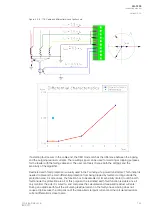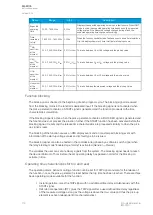
Event number
Event channel
Event block name
Event code
Description
5635
88
OV4
3
Trip OFF
5636
88
OV4
4
Block ON
5637
88
OV4
5
Block OFF
The function registers its operation into the last twelve (12) time-stamped registers; this information is
available for all provided instances separately. The register of the function records the ON event
process data for START, TRIP or BLOCKED. The table below presents the structure of the function's
register content.
Table. 5.3.10 - 107. Register content.
Date and time
Event
code
Fault
type
Pre-trigger
voltage
Fault
voltage
Pre-fault
voltage
Trip time
remaining
Used SG
dd.mm.yyyy
hh:mm:ss.mss
5440-5637
Descr.
L1-E…
L1-L2-L3
Start/Trip
-20ms voltage
Start/Trip
voltage
Start -200ms
voltage
0 s...1800s
Setting
group 1...8
active
5.3.11 Undervoltage protection (U<; 27)
The undervoltage function is used for instant and time-delayed undervoltage protection. Each
device with a voltage protection module has four (4) available stages of the function (U>, U>>, U>>>,
U>>>>). The function constantly measures phase voltage magnitudes or line-to-line voltage
magnitudes. Undervoltage protection is based on line-to-line voltages or to line-to-neutral voltages (as
the user selects). If the protection is based on line-to-line voltage, undervoltage protection is not
affected by earth faults in isolated or compensated networks. Undervoltage protection has two
blocking stages: internal blocking (based on voltage measurement and low voltage), or external
blocking (e.g. during voltage transformer fuse failure). The blocking signal and the setting group
selection control the operating characteristics of the function during normal operation, i.e. the user or
user-defined logic can change function parameters while the function is running.
The outputs of the function are the START, TRIP and BLOCKED signals. The undervoltage function
uses a total of eight (8) separate setting groups which can be selected from one common source.
The function can operate on instant or time-delayed mode. In time-delayed mode the operation can be
selected between definite time (DT) mode and inverse definite minimum time (IDMT).
The operational logic consists of the following:
• input magnitude selection
• input magnitude processing
• threshold comparator
• block signal check
• time delay characteristics
• output processing.
The inputs for the function are the following:
• operating mode selections
• setting parameters
• digital inputs and logic signals
• measured and pre-processed voltage magnitudes.
A
AQ
Q-F205
-F205
Instruction manual
Version: 2.04
© Arcteq Relays Ltd
IM00013
173
Summary of Contents for AQ F205
Page 1: ...AQ F205 Feeder protection IED Instruction manual ...
Page 2: ......













































